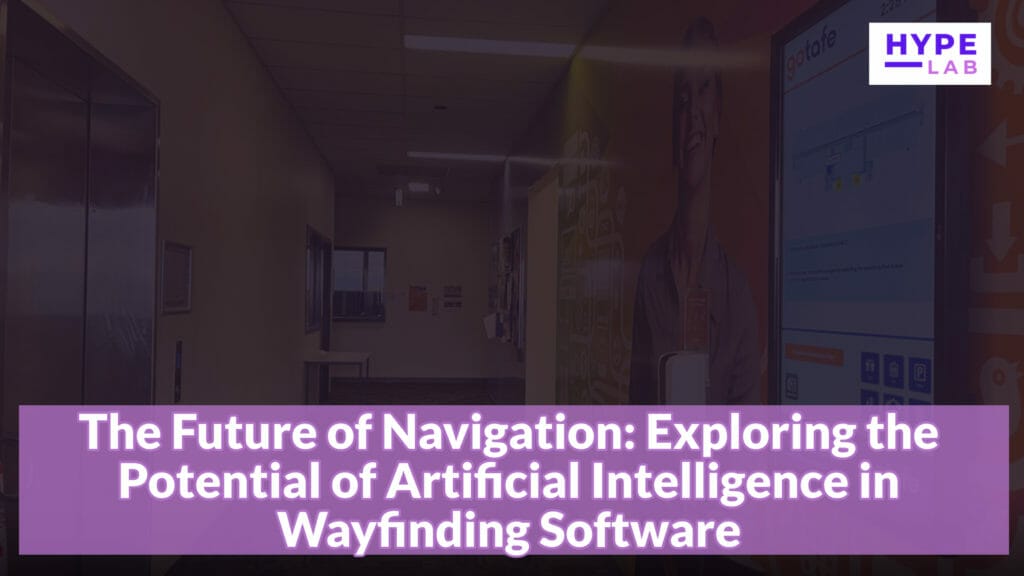
In today’s fast-paced digital world, navigation is key. Whether it’s finding your way through a busy airport or discovering the shortest route to a desired location, having efficient and user-friendly navigation tools is essential. Recognising this need, digital wayfinding software has emerged as a powerful solution to streamline navigation processes and change the way we find our way around. We will explore the benefits and capabilities of digital wayfinding software, delving into how it simplifies complex environments and empowers individuals with intuitive guidance at their fingertips. Prepare to discover the untapped potential of digital wayfinding as it paves the path towards effortless navigation in any setting.
- Ancient civilisations relied on maps etched on stone tablets or papyrus scrolls.
- These early maps provided a visual representation of landforms and key landmarks, helping travellers find their way from point A to point B.
- Later, paper maps became more common, providing people with portable navigation tools as they explored uncharted territories by foot, horseback, or ship.
Enter digital wayfinding software – the modern-day solution for efficient navigation:
- Digital wayfinding software has changed how we navigate our world.
- With advancements in technology and the widespread use of smartphones and GPS systems, people now have real-time access to accurate location information at their fingertips.
- This groundbreaking technology allows users to find the fastest route from one place to another while avoiding traffic congestion or construction delays.
From Airports to Hospitals: The Versatility of Digital Wayfinding Software in Various Settings
The Versatility of Digital Wayfinding Software in Various Settings
Digital wayfinding software is not just limited to airports and shopping centres. It can be used in a wide range of settings, including hospitals, universities, museums, and office buildings.
- Hospitals: Navigating through a large hospital complex can be overwhelming for patients and visitors. Digital wayfinding software helps them find their way easily by providing interactive maps with turn-by-turn directions to different departments and facilities.
- Universities: On sprawling campuses with numerous buildings and lecture halls, digital wayfinding software simplifies navigation for students and staff. It assists in locating classrooms, offices, libraries, and dining areas as well as student services like counselling centres or health clinics.
- Museums: Museums often house vast collections spread across multiple floors or exhibit spaces. Here too digital wayfinding uses interactive floor plans to guide visitors effectively from one display area to another while highlighting important exhibits along the route.
Irrespective of the setting where it is implemented—be it an airport terminal or a museum gallery—digital wayfinding software changes navigation by simplifying complex environments into straightforward paths that minimise confusion and save time. By streamlining navigation in various settings, this versatile technology enhances the user experience while reducing stress levels associated with finding one’s destination within unfamiliar premises.

Navigating Complex Environments Made Easy: The Power of Interactive Maps
Whether you’re in a sprawling hospital, a crowded shopping centre, or a massive conference venue, finding your way around can be a daunting task. Luckily, with the advent of digital wayfinding software and interactive maps, navigating complex environments has never been easier.
Simplify Navigation with Interactive Features
Interactive maps take navigation to the next level by providing users with real-time information and dynamic features. These maps are designed to be user-friendly and intuitive, allowing individuals to easily search for specific locations or points of interest within a given environment. With just a few clicks or taps on their smartphones or other devices, users can zoom in or out, rotate the map, and even switch between different floors or levels. This level of interactivity makes it simple for users to find their desired destination quickly and efficiently.
Real-Time Updates Ensure Accuracy
One major advantage of digital wayfinding software is its ability to provide real-time updates on routes and locations. Gone are the days when outdated paper maps led people astray. Now, interactive maps can incorporate live data such as traffic conditions, event schedules, and building occupancy rates. This ensures that users always have accurate information at their fingertips and helps them avoid unexpected obstacles along their intended path.
Using digital wayfinding software streamlines navigation through complex environments by offering interactive features that simplify the process for users. It provides real-time updates to ensure accuracy in directions and helps individuals find their desired destinations efficiently. With these advancements in technology, navigating unfamiliar places has become hassle-free for everyone involved.
Optimising Efficiency: Streamlining Navigation Processes with Digital Wayfinding Software
Optimising Efficiency with Digital Wayfinding Software
Digital wayfinding software has changed the navigation process in various industries. By streamlining navigation processes, it helps users efficiently reach their destinations without wasting time or energy.
- The software’s intuitive interface allows users to easily input their desired destination and receive clear directions.
- It eliminates confusion by providing step-by-step instructions, ensuring that users never get lost or take unnecessary detours.
- With real-time updates on traffic conditions and alternative routes, digital wayfinding software enables users to make informed decisions to avoid delays.
By optimising efficiency through streamlined navigation processes, businesses can save valuable resources such as time, employee productivity, and customer satisfaction. This powerful tool benefits not only individuals but also organisations aiming for increased operational effectiveness.
In conclusion, digital wayfinding software is a game-changer when it comes to optimising efficiency in navigating various settings like hospitals, universities, shopping malls and airports. Its ability to provide clear directions guided by real-time information minimises confusion along the journey – resulting in more efficient use of time and resources for both individuals and organisations alike.
Saving Time and Resources: The Cost-Effective Benefits of Digital Wayfinding Software
Digital wayfinding software offers numerous cost-effective benefits for businesses and organisations. Here are a few key advantages:
- Enhanced Efficiency: With digital wayfinding software, visitors can quickly find their destinations without the need for staff assistance or printed maps. This saves time both for visitors and staff members who would otherwise need to provide directions, freeing them up to focus on other tasks.
- Reduced Printing Costs: By eliminating the need for printed maps or directories, digital wayfinding software helps businesses save on printing costs. It also reduces waste by promoting a more environmentally friendly approach.
- Improved Visitor Experience: Digital wayfinding software provides interactive and user-friendly navigation tools that make it easier for visitors to navigate large buildings or campuses. Real-time updates ensure accuracy, while additional features like accessibility information help cater to the needs of diverse visitor groups.
- Decreased Staff Workload: Without constant inquiries about directions, staff members can dedicate more time to their core responsibilities rather than being tied up with repetitive tasks.
By implementing digital wayfinding software, businesses can streamline navigation processes while saving time, resources, and money in the long run.
Enhancing Safety and Security: How Digital Wayfinding Software Improves Emergency Response
Emergency situations require quick and efficient responses. Digital wayfinding software plays a vital role in enhancing safety and security during these critical moments. By providing real-time navigation guidance, it enables emergency responders to navigate unfamiliar environments swiftly.
Improved Situational Awareness
Digital wayfinding software enhances situational awareness for emergency response teams. With access to detailed maps and information on their smartphones or tablets, responders can quickly understand the layout of the building or area they are entering.
Efficient Resource Allocation
During emergencies, every second counts. Digital wayfinding software optimises resource allocation by helping responders identify the closest entry points or exits, shortest routes to individuals in need of assistance, and locations where additional support may be required.
Streamlined Collaboration
Collaboration among different emergency response units is crucial for effective crisis management. Digital wayfinding software facilitates seamless communication between teams by providing a centralised platform through which key information can be shared instantly.
Return on Investment: The Cost-Benefit Analysis of Implementing Digital Wayfinding Software
Using digital wayfinding software can result in a significant return on investment (ROI) for organisations.
- Improved customer experience: Digital wayfinding software helps visitors easily navigate complex spaces, reducing frustration and increasing satisfaction. This positive experience leads to increased customer loyalty and repeat business.
- Efficiency gains: With digital maps and directions at their fingertips, employees can quickly find their desired locations, saving valuable time. This increased efficiency translates into cost savings by optimising staff productivity.
- Reduced staffing costs: By implementing digital wayfinding software, organisations can potentially reduce the number of personnel needed to guide visitors or provide assistance, resulting in long-term labour cost savings.
In summary, the implementation of digital wayfinding software offers numerous benefits including improved customer experiences, efficiency gains, and potential reductions in staffing costs. These advantages contribute to a positive ROI for organisations implementing this technology.

The Future of Navigation: Exploring the Potential of Artificial Intelligence in Wayfinding Software
Artificial intelligence (AI) has immense potential to change wayfinding software, offering a glimpse into the future of navigation. By leveraging AI algorithms and advanced data analysis techniques, digital wayfinding software can provide personalised, real-time guidance to users. Machine learning capabilities enable these systems to continuously improve their performance by learning from user interactions and feedback.
One key benefit of AI-powered wayfinding software is its ability to adapt in real time to changing circumstances. Whether it’s finding the quickest route through traffic or navigating complex indoor environments like airports or shopping malls, AI algorithms can process vast amounts of data quickly and make informed decisions that take various factors into account.
Additionally, as AI becomes more sophisticated, voice recognition technology could further enhance navigation experiences. Imagine asking your smartphone for directions and receiving spoken instructions tailored specifically for you – taking into consideration your preferences and past behaviour patterns.
Artificial intelligence holds great promise for enhancing digital wayfinding software by providing personalised guidance based on real-time information. As this technology continues to evolve, we can expect seamless navigation experiences that are tailored precisely to individual needs and preferences.


 Previous Post
Previous Post Next Post
Next Post